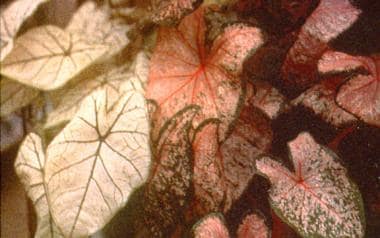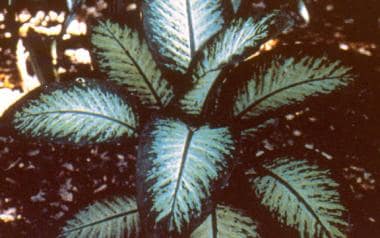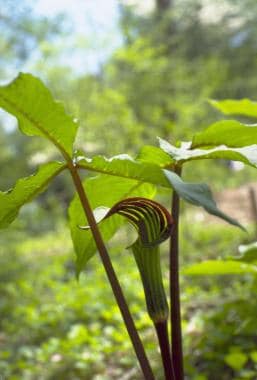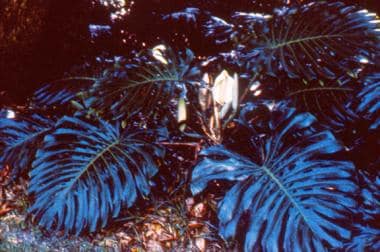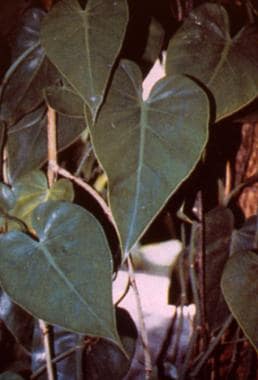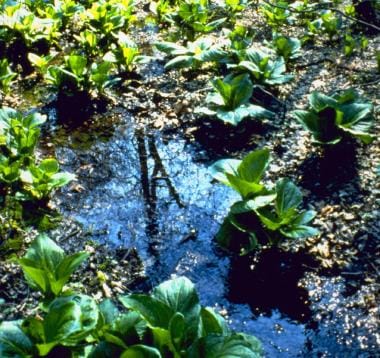Practice Essentials
Plant exposures are some of the most frequent poisonings reported to poison control centers. Exposures to plants containing oxalate crystals, such as Philodendron and Dieffenbachia, are among the most common toxic plant exposures reported in the United States.
Historically, the irritant properties of the Dieffenbachia plant have had various uses, including punishing slaves and treating gout, impotence, and frigidity. Currently, plants containing oxalate are admired for their ornamental beauty and found in public places and homes.
The following plants contain oxalates:
-
Anthurium ( Anthurium species) [1]
-
Arum, Araceae ( Arisaema species)
-
Caladium ( Caladium bicolor) (see the image below)
-
-
Calla lily ( Zantedeschia species)
-
Chinese evergreen ( Aglaonema species)
-
Dieffenbachia ( Dieffenbachia species) [2] (see the image below)
-
-
Jack-in-the pulpit ( Arisaema triphyllum) (see the image below)
-
-
Monstera, Ceriman ( Monstera deliciosa) (see the image below)
-
-
Nephthytis ( Syngonium podophyllum)
-
Philodendron ( Philodendron species) (see the image below)
-
-
Pothos or Hunter's robe ( Epipremnum aureum)
-
Skunk cabbage ( Symplocarpus foetidus) (see the images below)
-
Pathophysiology
Nonsoluble calcium oxalate crystals are found in plant stems, roots, and leaves. The stalk of the Dieffenbachia plant produces the most severe reactions. These needlelike crystals produce pain and edema when they contact lips, tongue, oral mucosa, conjunctiva, or skin. [3] Edema primarily is due to direct trauma from the needlelike crystals and, to a lesser extent, by other plant toxins (eg, bradykinins, enzymes). [4, 5]
Epidemiology
Philodendron and Dieffenbachia exposures are among the most common plant exposures reported to poison control centers. The 2021 Annual Report of the American Association of Poison Control Centers' National Poison Data System (NPDS), documented 5840 single exposures for oxalate plant poisonings. [6]
The majority of oxalate plant exposures occur in children younger than 5 years while sampling houseplants in the home. The 2021 NPDS report noted 4204 oxalate plant exposures in those younger than 6 years, 713 exposures in those aged 6-12 years, 179 in those 13-19 years old, and 561 exposures in those age 20 years and older. [6]
Prognosis
Most patients who have been exposed to plants containing oxalates completely recover. In most cases, nonsoluble oxalate plants produce self-limited symptoms and clinical manifestations. Significant morbidity or mortality is extremely rare. However, there are case reports of severe oropharyngeal inflammation and edema, with impending obstruction of the upper airways. [7]
The 2021 Annual Report of the American Association of Poison Control Centers' NPDS reported 1225 minor outcomes, 80 moderate outcomes, and 4 major outcomes, but no deaths from oxalate plant exposures. [6]
-
Jack-in-the-Pulpit
-
Skunk Cabbage
-
Skunk Cabbage
-
Dieffenbachia, commonly known as dumb cane
-
Caladium
-
Philodendron
-
Monstera deliciosa

